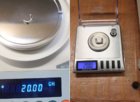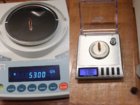I have posted that I recently picked up a Sartorius CP432S Analytical Lab Scale. I had been using a Lyman G6 powder scale and dispenser with a Dandy trickler. I have read many posts where reloaders have said using an analytical scale is not necessary to produce accurate competition loads. That they get consistent loads using inexpensive ($100-$200) digital scales or beam scales.
So armed with my new analytical scale, I wanted to first ensure that the 42.9 gr load that I thought I had been measuring with the G6 was in deed 42.9 gr or if not, what it really was for future reference. Secondly, I wanted to see how much my loads actually varied. Lastly, to see if there is a difference between an inexpensive scale and an analytical lab scale. For reference the Sartorius CP423S scale sold for $1800 new. I purchased it for far less at an auction but it has been calibrated and serviced by a professional service on 1/24/2019 according to the sticker on the scale.
I have tried to use the G6 to do precision loading. I would calibrate every use and very often during reloading I had to zero the scale as it would creep. The pan weights 111.08 Gr. The reading on the scale with the pan removed would vary from 110.9 to 111.4 gr. So I constantly had to zero the scale to correct this. It was not unusual for me to have to pull 300-400 loads from the scale to get 100 usable loads. This of course made for very long, frustrating days.
To do my comparison, I duplicated my process on the G6 that entailed having it measure a load of 42.8 gr and then trickle the last 0.1 gr in a kernel at a time until the scale read 42.9 gr. I then moved the pan to the CP423S scale to verify the load. I zeroed the G6 each time to ensure that I eliminated the creep and ensure I am starting from the same place each time. The creep happened 8 times out of the 11 loads I pulled.
The Statistics:
Desired Load: 42.9 gr
Average Load 43.05 gr
SD: 0.14 gr
SE: 0.44 gr
I have attached some pictures for you to see. Here is the description of each picture in order.
1) The scales after zeroing both with the same pan then removing the pan The difference is 0.02 gr.
2) The powder load after I trickled the last bit producing the 42.9 gr load.
3) The load actually measured 43.1 gr, you can see the G6 scale now reads 111.1 instead of 110.9 gr.
4) The last pic is of my note pad.
A) The first column is shows I had to zero each measurement.
B) The second is the G6 scale reading after dispensing and trickling.
C) The third is the scale after the pan was removed. Notice the creep.
D) The fourth shows that I didn’t have to zero the GP423S with the exception of the first time.
E) The G6 load measured on the GP423S.
F) The pan removed weight on the GP423S. It stayed constant at 111.08 gr.
I hope that you find this information interesting.




So armed with my new analytical scale, I wanted to first ensure that the 42.9 gr load that I thought I had been measuring with the G6 was in deed 42.9 gr or if not, what it really was for future reference. Secondly, I wanted to see how much my loads actually varied. Lastly, to see if there is a difference between an inexpensive scale and an analytical lab scale. For reference the Sartorius CP423S scale sold for $1800 new. I purchased it for far less at an auction but it has been calibrated and serviced by a professional service on 1/24/2019 according to the sticker on the scale.
I have tried to use the G6 to do precision loading. I would calibrate every use and very often during reloading I had to zero the scale as it would creep. The pan weights 111.08 Gr. The reading on the scale with the pan removed would vary from 110.9 to 111.4 gr. So I constantly had to zero the scale to correct this. It was not unusual for me to have to pull 300-400 loads from the scale to get 100 usable loads. This of course made for very long, frustrating days.
To do my comparison, I duplicated my process on the G6 that entailed having it measure a load of 42.8 gr and then trickle the last 0.1 gr in a kernel at a time until the scale read 42.9 gr. I then moved the pan to the CP423S scale to verify the load. I zeroed the G6 each time to ensure that I eliminated the creep and ensure I am starting from the same place each time. The creep happened 8 times out of the 11 loads I pulled.
The Statistics:
Desired Load: 42.9 gr
Average Load 43.05 gr
SD: 0.14 gr
SE: 0.44 gr
I have attached some pictures for you to see. Here is the description of each picture in order.
1) The scales after zeroing both with the same pan then removing the pan The difference is 0.02 gr.
2) The powder load after I trickled the last bit producing the 42.9 gr load.
3) The load actually measured 43.1 gr, you can see the G6 scale now reads 111.1 instead of 110.9 gr.
4) The last pic is of my note pad.
A) The first column is shows I had to zero each measurement.
B) The second is the G6 scale reading after dispensing and trickling.
C) The third is the scale after the pan was removed. Notice the creep.
D) The fourth shows that I didn’t have to zero the GP423S with the exception of the first time.
E) The G6 load measured on the GP423S.
F) The pan removed weight on the GP423S. It stayed constant at 111.08 gr.
I hope that you find this information interesting.
















